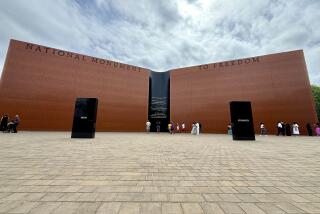Op-Ed: Add this to the courthouse lawn — a memorial to lynching
As is common throughout the South, the lawn at the Clarke County Courthouse in Mississippi, is peppered with monuments. A granite marker lists the Ten Commandments, and a veterans memorial honors residents who fell in foreign wars. A Confederate soldier tops another granite monument installed over a century ago: “Though Your Ranks Now Fast Are Melting,” the inscription reads, “and the Stars and Bars Are Furled. Yet the South Will Live Forever In the Glory of Your World.”
Now the Equal Justice Initiative, a legal advocacy organization in Montgomery, Ala., proposes to add another monument to the courthouse lawn: a six-foot-high, rust-colored steel column inscribed with the names of Ernest Green, Charlie Lang and eight other African Americans lynched in Clarke County.
On Thursday, the National Memorial for Peace and Justice — known, informally, as the lynching memorial — opens to the public in Montgomery, the first capital of the Confederacy. It consists of 805 engraved columns, a county-by-county listing of the names and dates of death of the victims of “racial terror lynching” in the United States. Since 2010, the Equal Justice Initiative has meticulously documented the deaths — 4,400 and counting. On the grounds surrounding the memorial structure lie 805 additional columns, duplicates of those on permanent display, waiting for county officials from across the country to claim them and take them home.
As those duplicate markers disappear from the site — if they disappear — the memorial will begin to fill in a gap in American history, recognizing the thousands who died at the hands of mobs that lynched with impunity as local government looked away, or worse, participated.
Green and Lang were accused of attempted rape by a white girl in Shubuta, Miss., in October 1942. Local officers jailed the two black boys, barely in their teens, on specious evidence and then failed to stop vigilantes from seizing them from the Clarke County jail and hanging them from a nearby bridge.
Several days after the lynching, a New York reporter met Clarke County’s sheriff in his patrol car, parked in front of the courthouse. Behind it stood the adjoining jailhouse, where a midnight posse had abducted the two black boys with remarkable ease.
“First off, the papers got the ages wrong,” the sheriff complained. “You better put it down. Them niggers wasn’t 14, they were maybe 16 to 18.” His halfhearted investigation had yielded no leads, as he put it, because “people don’t like to tell on their friends.” As for killing black boys — who were in fact 14 and 15 — he explained, “We’re all for law and order here. But, of course, we got some good folks who get kind of wild.”
The sheriff’s words echo the Equal Justice Initiative’s research, which confirms that communities bore a collective responsibility for killings they failed to stop and killers they refused to punish. By tabulating and memorializing victims of racial terror by county, the EJI follows in a long tradition of anti-lynching activists who stressed the complicity of local officials in mob violence. And though many lynchings occurred literally “on the courthouse lawn,” as NAACP Legal Defense Fund director Sherrilyn Ifill notes in a masterful study titled just that, far more occurred with the acquiescence or outright assistance of the courthouse clique. This is why federal anti-lynching legislation, proposed numerous times yet never passed by Congress, stipulated penalties not only for those who lynched but for law officers and county officials who allowed a lynching to occur on their watch.
The EJI’s offer of ready-made monuments is as much a challenge as an invitation to the counties represented by the steel columns assembled and arrayed in Montgomery. That aspect of the memorial answers the call — or calls the bluff — of public officials who have responded to demands for the removal of Confederate statues by arguing for, as Vice President Mike Pence put it, “more monuments, not less.” Will the hundreds of communities that already make room for monuments to white supremacy now find space for a memorial to victims of white supremacist violence?
Jason Morgan Ward is professor of history at Mississippi State University and author of “Hanging Bridge: Racial Violence and America’s Civil Rights Century.”
Follow the Opinion section on Twitter @latimesopinionand Facebook
More to Read
A cure for the common opinion
Get thought-provoking perspectives with our weekly newsletter.
You may occasionally receive promotional content from the Los Angeles Times.










